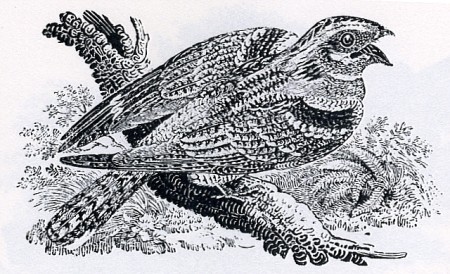May 5
Posted by sydney on May 5th, 2009

Fernowl or Nightjar, Caprimulgus europaeus.
- 1793: May 5, 1793 – Damson, sloe-trees, & wild Merise blow. Cock Red start. There has been so little frost, that the Antirrhinum Cymb. flourished & blossomed the whole winter thro’, & is now very thriving, tho’ it usually dies about Xmass. So that, in mild times, it is at least a biennial with us, & may be perhaps of longer duration in milder regions. James Knight has observed two large fieldfares in the high wood lately, haunting the same part, as if they intended to breed there They are not wild. A nest of this sort of bird would be a great curiosity.
- 1791: May 5, 1791 – The bloom on my white apple is again very great. Set the middle Bantam hen with eleven eggs: the cook desired that there might be an odd one.
- 1789: May 5, 1789 – The Fern-owl, or Goat-sucker chatters in the hanger This curious bird is never heard till warm weather comes: it is the latest summer bird except the fly-catcher.
- 1788: May 5, 1788 – The great oak in the mead abounds with male bloom.
- 1787: May 5, 1787 – Sowed ten weeks stocks, & radishes, & lettuces.
- 1784: May 5, 1784 – Cut the first cucumber, a large one. Golden weather. The polyanths blow finely, especially the young seedlings from Bramshot-place, may of which will be curious. Shot three green-finches, which pull-off the blossoms of the polyanths.
- 1781: May 5, 1781 – No rain enough to measure.
- 1779: May 5, 1779 – The swifts which dashed-by on saturday last have not appeared since; & were therefore probably on their passage.
- 1776: May 5, 1776 – Showers all day, with hail, & wind. The ground is pretty well moistened.
- 1775: May 5, 1775 – House-snails abound now: scarce any have appeared before on account of the long drought.
- 1774: May 5, 1774 – Grass grows, & is forward. Apple-trees blow. Plums shew little bloom.
- 1770: May 5, 1770 – Clouds, great rain.
- 1768: May 5, 1768 – Green gooseberries.
Notes:
The Fern-owl, or Goat-sucker, or Eve-jar, or Night-jar, or Caprimulgus is a nocturnal bird something between an owl and a swallow. North Americans from quiet rural areas may know its close relative the whip-poor-will. The UK Forestry Commission has a handy list of places to go to spot, or at least hear this rare bird. Song of the nightjar from the wonderful Kalerne.
 Theme Ported to
Theme Ported to